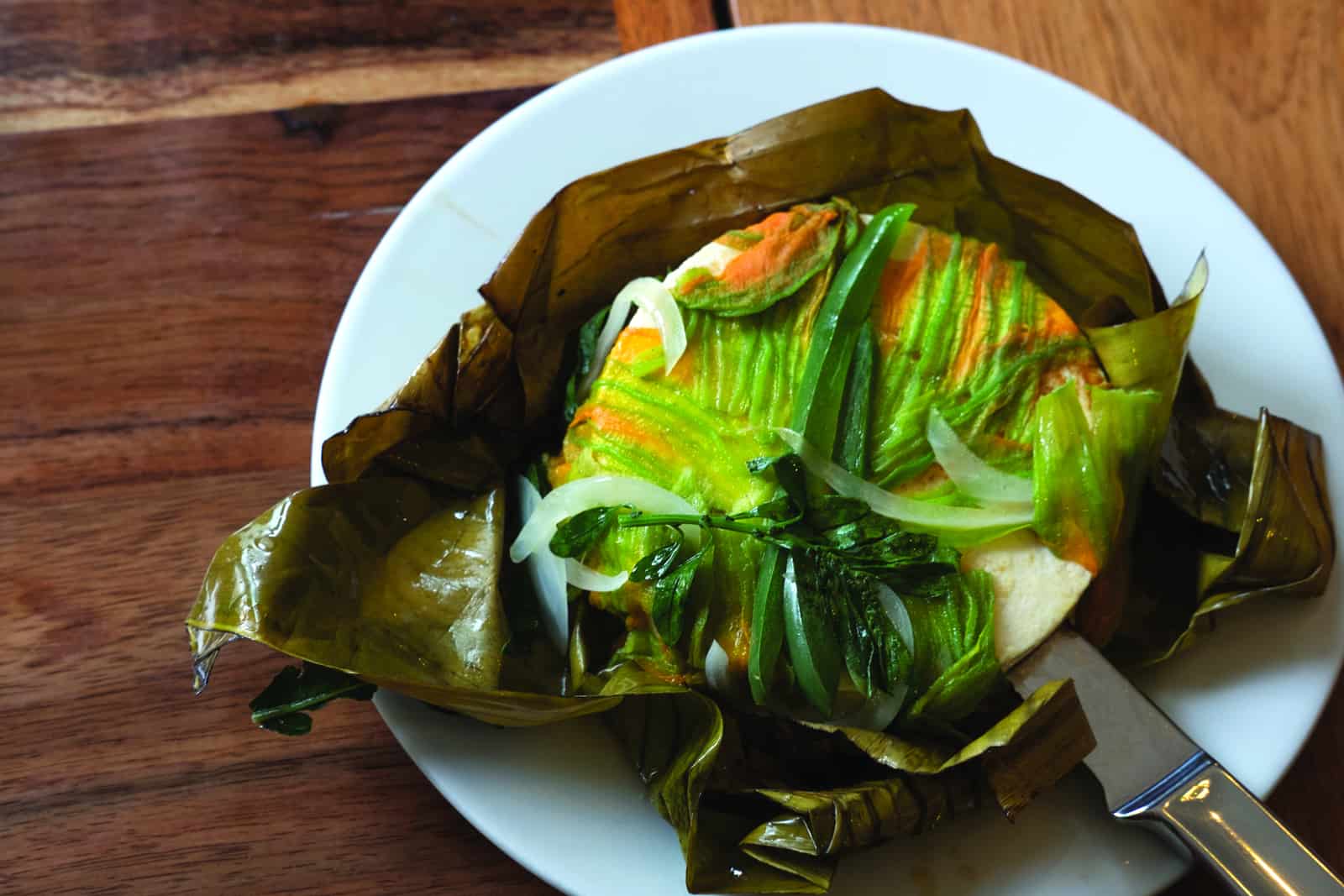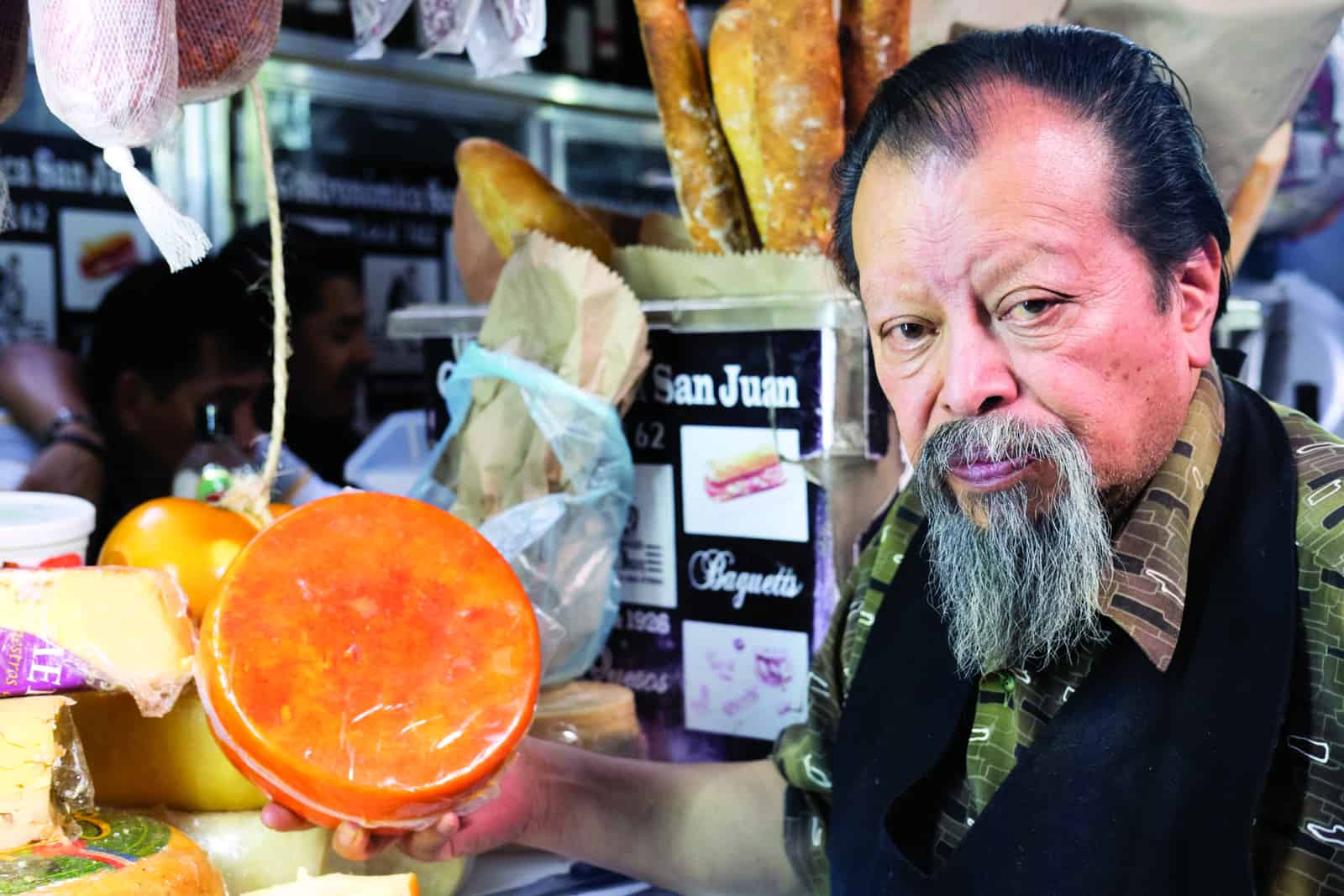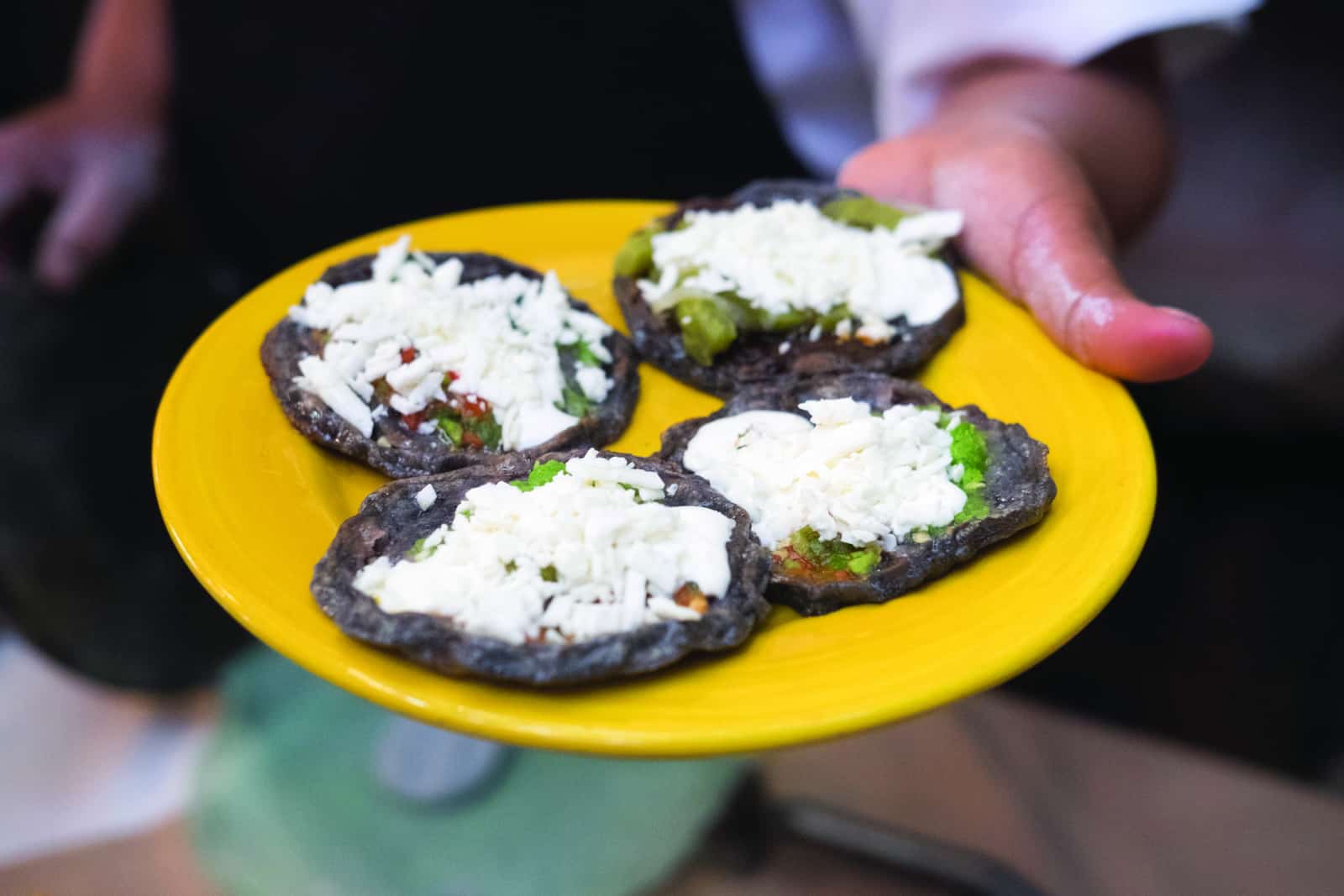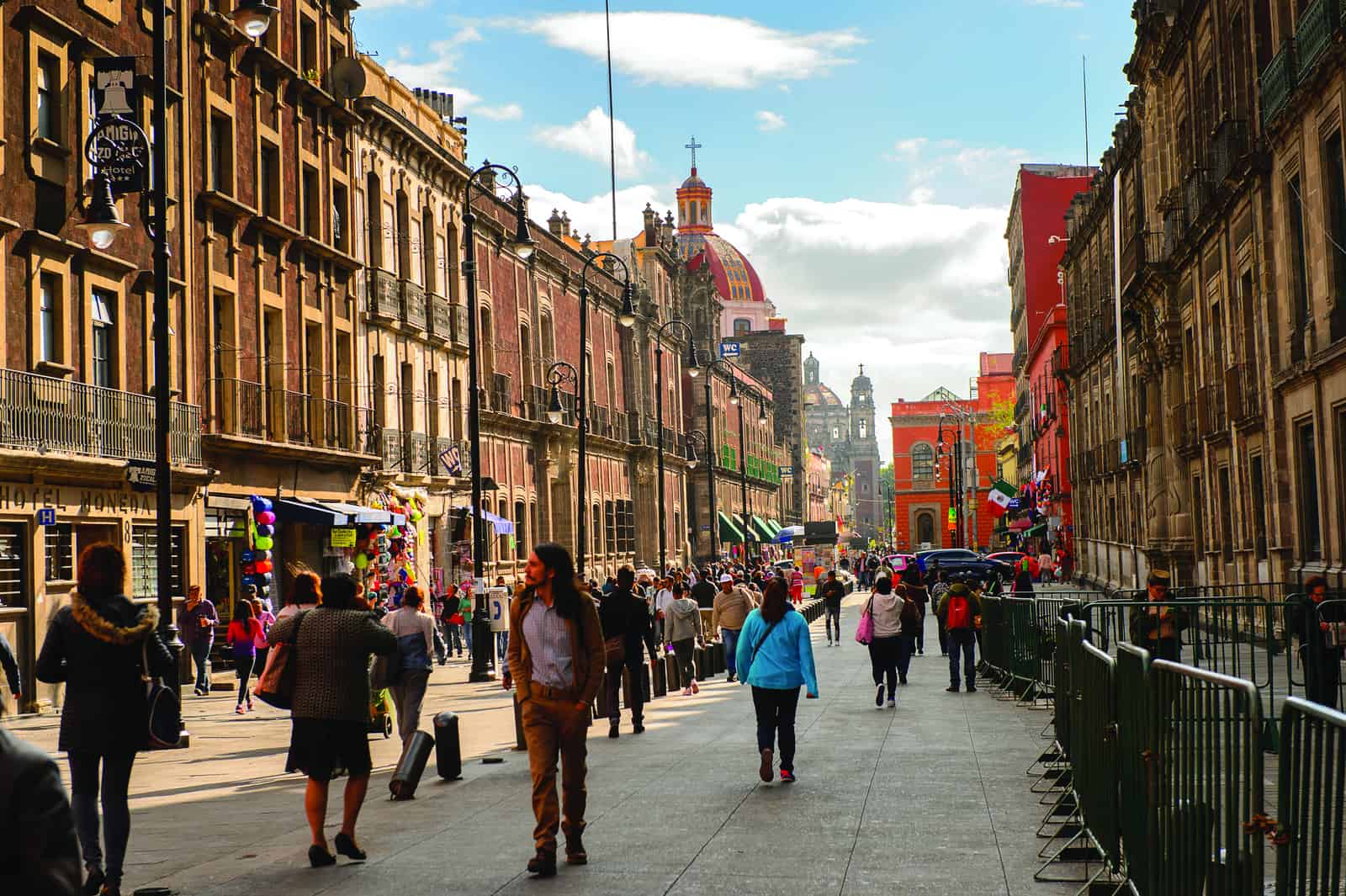
In Mexico City, you can hardly go dos pasos without tripping over cheese. Queso-laced street foods abound, such as elotes—grilled corn slathered with mayonnaise and sprinkled with crumbled cheese—and hand-patted blue corn quesadillas stuffed with melted quesillo and squash blossoms or huitlacoche, a delicious corn fungus. But this bustling metropolis is also the perfect place to seek out the country’s wide range of lesser-known artisanal and traditional wheels—that is, if you know where to look.
An estimated 25 percent of Mexico’s milk is made into cheese, an integral ingredient in its national cuisine. But the country still lags behind the United States when it comes to recognizing artisan cheese culture, says Carlos Yescas, co-founder of Mexico City–based cheese distributor Lactography. “It’s a country where the Slow Food Movement has had a big impact,” Yescas says—but much of the attention has been directed toward foods like mezcal, beans, and corn, while Mexican cheeses have been dismissed as a product of European tradition, leaving artisan dairy producers lacking support.

And while economic woes and logistical barriers make it difficult to transport rurally made cheese to the city, companies like Lactography are making it happen. At the same time, the growth of high-end restaurants—with chefs who truly care about their ingredients—has helped support artisanal cheese distribution in Mexico City, biting off a little chunk of the market from the ubiquitous commodity cheeses.
At El Cardenal, a three-story restaurant in the heart of the city’s historic center, chefs opt for a house-made version of panela, a smooth, moist fresh cheese you’ll encounter frequently in Mexico. Here, it’s cubed and served in a molcajete (a traditional stone mortar) with avocado and a pool of green salsa. El Cardenal makes its own cheeses at its ranch—all the more reason to order any of the dairy-based dishes, like the nata (clotted cream) with fresh-baked concha rolls and the poblano chile stuffed with Mexican manchego, a butter-yellow, semi-firm cheese with little resemblance to its Spanish namesake.
Across the city, dishes with quesillo or queso Oaxaca grace restaurant menus. While supermarket versions of this stretched-curd white cheese can be overly greasy, sweet, and tough, reputable versions yield a delightful tang in their tender strings (the cheese was traditionally made from the previous day’s sour milk). It first arrived in Mexico City with the Oaxacans, who came to help build the subway, but the beautifully melty cheese quickly took up permanent residence, especially among street foods known as “vitamin T”: tacos, tortas, tamales, tlacoyos, and more. “It’s my favorite Mexican cheese,” says chef Martha Ortiz of Dulce Patria, a contemporary Mexican restaurant in the Las Alcobas hotel. She uses it in her multicolored quesadillas. “It’s so artistic, how they make it: small or big, braided, fresh, with more cream in it, salty or not salty. But round—like the world of cheese.”

To purchase some of Mexico’s most interesting cheeses, head to the Mercado San Juan. Among the city’s many traditional public markets (all of which boast at least one cheese vendor, if not a half dozen), this one, open daily, is a quality standout. Culinary tour guide Anais Martinez, aka the Curious Mexican, jokes that San Juan is the city’s version of Whole Foods—it’s less of a standby for everyday ingredients and more of a destination for indulging in fancy flourishes.
José Juárez Farfán has worked at the Gastronómica San Juan stall for 46 years. A third-generation cheese seller, he began working here at eight years old with his grandfather. Now he works with his own son: the fourth generation. Like Yescas, he sees progress in support of Mexican cheese, but still has concerns. “Now people want more organic or natural, but what’s right is artisanal.”
The market stall includes a few tables where shoppers can sample cheese-based foods and wines, as well as a cheese case chock-full of both imported and domestic wheels. Farfán offers fontina made in Veracruz, a square Mexican emmental from San Juan del Rio, and a raw-milk brie from Puebla. Along with these European-inspired cheeses—which are a fascinating study in terroir and adaptation—he sells typical Mexican styles like queso Chihuahua, a squeaky cheese often made by Mennonites; depending on the time of year, it expresses a sharpness reminiscent of cheddar. Farfán’s inventory changes often, depending on the season, but he always has ample stock and will put together a tasting—complete with a glass of wine—for customers.
Sampling dairy at the market or in the city’s ever-expanding roster of acclaimed restaurants unveils the work of Mexico’s artisans: cotija made in Michoacán’s hills; creamy, soft Chiapas cheese molded into a square; and buffalo mozzarella made in Tabasco. But you can also experience the ubiquity of quesillo on street corners, queso fresco with almost any meat dish, and panela on appetizer platters. Together, these discoveries are evidence of the city’s cheese culture: a multifaceted cuisine that’s ripe for exploration.

EAT
Sneak away from the crowded pedestrian streets of the historic center and follow the hordes of Mexican families toward this classic spot. Browse the giant menu of traditional cuisine while listening to live music, but don’t miss any of the cheese-based specialties: The queso comes from the restaurant’s own ranch.
The stunning arched dining room gives an immediate hint of the ambition behind this Italian eatery. While the handmade pastas earn plenty of praise, the most interesting dishes result from chef Marco Carboni’s mingling of locally made cheeses (like an artisanal stracciatella from Mexico State) and Mexican techniques with his Italian training, exemplified by the souffle-like tamale with hoja santa, parmesan, and ricotta.
Enrique Olvera’s famed restaurant Pujol gets booked months in advance for the multicourse tasting menus, but Mexico City’s best-known chef also runs a handful of casual cafés. Start your morning with chicken and Mexican manchego enchiladas, or linger over a cheese plate with camembert from Zacatlán, Itálico from San Miguel de Allende, and a semi-aged sheep’s milk cheese with a red wine–rubbed rind from Querétaro.
Jorge Vallejo’s Quintonil has quietly snuck ahead of Pujol in worldwide restaurant rankings, serving up local and heirloom ingredients via modern approaches to traditional flavors and ingredients. Look for dishes like amaranth blossoms in a creamy tomato sauce, topped with Chiapas cheese.

DRINK
This natural wine bar boasts a fantastic list in a bottom-floor, cellar-esque room. While most of the wines hail from abroad (Chile, France, and Spain), there are a few homegrown options to sip as you dig into dishes like burrata with spinach, kale, and anchovies, or a selection of cheeses served with honey and thick, crusty bread.
Bósforo
The city’s best mezcal bars seems to have infinite varieties of the signature tipple, plus bartenders brimming with the knowledge to guide rookies and experts alike toward a favorite. You’ll need their help, since almost none of the bottles are labeled; this stuff is too small-batch to be exported. When it comes to pairing food, though there are limited options at this hip Centro Histórico hot spot—don’t miss the quesadilla made with a fresh blue corn tortilla and chapulines (grasshoppers).
SHOP
Tianguis de Martes, Condesa
On Tuesdays, a small flea and farmers’ market sets up along a few blocks of the western edge of the Condesa neighborhood. At one end you’ll find a truck selling cheeses, and about halfway through, a set of tents filled with booths of people cooking all kinds of food.
Calle Pachuca
Gastronómica San Juan
Mexico City’s traditional markets offer endless aisles of unique vendors, and the gourmet-focused Mercado San Juan holds gems like this third-generation cheese shop. Pop into one of the small tables facing the cheese cases, order a glass of wine, and ask for a tasting of the many local Mexican cheeses stacked next to—and on par with—the imported ones.
2da Calle de Ernesto Pugibet 77 L-162
+52 55 5510 2685
Productos Oaxaqueños
If you stay at the Hotel Carlota (see below), there’s a cheese truck parked just down the block. On weekdays, a vendor sells wares from a refrigerated vehicle. Along with traditional snacks and candies from Oaxaca, they offer a half dozen fresh and smoked cheeses, including quesillo, panela, and cotija. Look for similar trucks around town if you’re elsewhere.
Corner of Río Lerma and Río Amazonas
STAY
Hotel Carlota
Just off the Reforma, one of the city’s most dynamic boulevards, this updated hotel weaves mid-century Mexican modernist design with an unbeatable location and a rare bonus in Mexico City hotels: a pool. The bar—on the pool deck—serves snacks from its acclaimed restaurant alongside its drinks, including a cheese plate, cheese-stuffed masa cakes called [ital]bocoles[ital], and a panela and avocado sandwich.
+52 55 5511 6300
If you like your dairy with a side of luxury, book a room at this impeccable Polanco hotel, which offers as many selections for bath soap as it does for breakfast—and the latter includes enfrijoladas, a Oaxacan specialty of black bean sauce and cotija-coated chips, served with scrambled eggs and quesillo. Both restaurant options—the world-famous Dulce Patria and Anatol—are stunning; don’t miss the squash blossoms stuffed with three cheeses and topped with parmesan at the latter.
A Taste of Juárez
Bridging the gap between the historic center of Mexico City and its trendy Roma quarter, the Juárez neighborhood has location locked down. In the last few years, Roma’s culinary reputation has spilled into the old mansions and modern constructions of the neighborhood. In one old house you’ll find Café Nin, the coffee shop from renowned chef Elena Reygadas (of Rosetta and Lardo), which serves baked goods like a guava and cheese–stuffed pastry, and a mid-day menu that includes a burrata-topped version of the city’s classic breakfast, chilaquiles.
Sadly, despite queso-laden menus, La Juárez lacks a cheese shop. But Ojo de Agua, a health-focused juice bar and restaurant, curates a nice selection, including goat cheese, quesillo, and panela from its shop in the new Milán 44 food hall, where you can pop in for a coffee before slipping down to café Chocolatería La Rifa for a snack. Eat or drink your chocolate in dozens of forms at La Rifa, including in a tamale filled with nata (clotted cream).
Finish off your day in the neighborhood at Hanky Panky. You’ll need to call ahead for a reservation, and for directions—the speakeasy is hidden at the back of a taco shop. But once inside, you’ll be treated to some of the city’s best cocktails, alongside snacks like smoked provolone with sausage and parsley.




